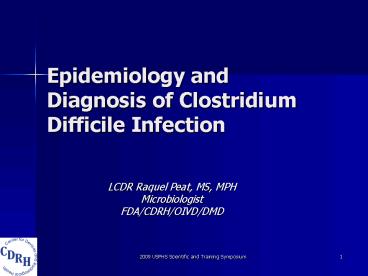Epidemiology and Diagnosis of Clostridium Difficile Infection PowerPoint PPT Presentation
1 / 30
Title: Epidemiology and Diagnosis of Clostridium Difficile Infection
1
Epidemiology and Diagnosis of Clostridium
Difficile Infection
- LCDR Raquel Peat, MS, MPH
- Microbiologist
- FDA/CDRH/OIVD/DMD
2
- The findings and conclusions in this presentation
are those of the author and do not necessarily
represent the views of the Food and Drug
Administration
3
Overview
- Review current epidemiologic trends in
Clostridium difficile - Review current knowledge regarding pathogenesis
of Clostridium difficile disease - Identify novel devices that aid in the diagnosis
of Clostridium difficile. - Eradication
4
Clostridium difficile
- Anaerobic spore-forming bacillus
- Clostridium difficile-associated disease (CDAD)
- Pseudomembranous colitis, toxic megacolon,
sepsis, and death - Fecal-oral transmission through contaminated
environment and hands of healthcare personnel - Antimicrobial exposure is major risk factor for
disease - Acquisition and growth of C. difficile
- Suppression of normal flora of the colon
- Clindamycin, penicillins, and cephalosporins
Healthy colon
Pseudo-membranous colitis
5
Background
- Clostridium difficile is responsible for 20 of
all cases of antibiotic associated diarrhea and
has been increasingly recognized as a major
nosocomial pathogen - Barbut, F. Journal of Clinical Microbiology. June
2000. p2386-2388
6
Annual CDAD Rates, Hospitals with gt500 Beds,
Intensive Care Unit Surveillance Component, NNIS
From Archibald LK, et al. J Infect Dis.
20041891585158.
7
Clostridium difficile infection
- Range in severity from asymptomatic to severe and
life- threatening - Many deaths have been reported
- Infected in hospitals, nursing homes, or
institutions - Outpatient setting is increasing
8
National Estimates of US Short-Stay Hospital
Discharges with C. difficile as First-Listed or
Any Diagnosis
From McDonald LC, et al. Emerg Infect Dis.
200612(3)409-15
9
Rates of US Short-Stay Hospital Discharges with
C. difficile Listed as Any Diagnosis by Age
From McDonald LC, et al. Emerg Infect Dis.
200612(3)409-15
10
Rates of US Short-Stay Hospital Discharges with
C. difficile Listed as Any Diagnosis by Region
From McDonald LC, et al. Emerg Infect Dis.
200612(3)409-15
11
Potential Reasons for Increased CDAD Incidence
and Severity
- Changes in underlying host susceptibility
- Changes in antimicrobial prescribing
- New strain with increased virulence
- Changes in infection control practices
12
BI/NAP1 C. difficile Strain
- Virulent
- Produce greater quantities of toxins A and B
- Resistant to the antibiotic group
13
Epidemic (BI/NAP1) Strain
From McDonald LC, et al. N Engl J Med.
20053532433-2441.
14
(No Transcript)
15
Retail Meats
- C. difficile organisms, including recently
identified human epidemic strains, have been
identified in retail meats, including beef, pork,
turkey and ready-to-eat meats - It is not known how these bacteria got into the
meat
16
Pathogenesis of C difficile-associated disease
17
Anaerobic Stool Culture
- Not specific for toxin-producing bacteria
- asymptomatic patients may have positive stool
cultures because of colonization of nontoxigenic
strains - Results are available within 2 to 5 days
18
Toxigenic bacterial culture
- Organisms are cultured on selective medium and
tested for toxin production - Enrichment debate vs direct plating
- Methods not standardized
- Results are available within 2 to 5 days
- Clinical and Laboratory Standards Institute.
2004. Protocol for Determination of Limits of
Detection and Limits of Quantitation Approved
Guideline (EP17-A)
19
Cell Culture Cytotoxin assay
- Toxigenic anerobic cell culture toxin testing
- gold standard laboratory test
- Detecting toxin A and B strains
- Sensitivity 94-100
- Specificity 99
- 24 to 48 hours for results
- Fekety R, Shah AB. Diagnosis and treatment of
Clostridium difficile colitis. JAMA 199326971-5
20
Enzyme immunoassays (ELISA)
- Detect toxin A or B
- 2 to 6 hours for results
- Sensitivity 70-90
- Specificity 99
- Limitations
- False positive- grossly bloody stool
- False negative- if the toxin was not being shed
by the isolate at the time the sample was
obtained - Lack of correlation with severity of the disease
- Inability to perform repetitive analyses because
toxins degrade over time - Fekety R, Shah AB. Diagnosis and treatment of
Clostridium difficile colitis. JAMA 199326971-5
21
Latex agglutination
- Detect glutamate dehydrogenase
- Convenient and inexpensive
- gt30 minutes
- Not reliable
- Fekety R, Shah AB. Diagnosis and treatment of
Clostridium difficile colitis. JAMA 199326971-5
22
Change we can believe in
23
Molecular Testing
- Recently cleared by FDA
- Sensitivity 90-100
- PPV76
- NPV 99
- Rarely used in laboratories
- Peterson, LR et a. Clin Infec Dis. 2007, 45
1152-1160
24
Endoscopy
- Major non-laboratory procedure for detecting C.
difficile - Should only be pursued in special cases
- Immediate results
- Limitations
- Expensive to perform
- Require trained personnel
- Contraindicated in patients with toxic megacolon
due to the risk of bowel perforation - Fekety R, Shah AB. Diagnosis and treatment of
Clostridium difficile colitis. JAMA 199326971-5
25
Advantages and disadvantages of diagnostic
testing methods for C difficile
26
Relative Sensitivity of C. difficile Tests
- Culture toxin confirmationgt
- GDH EIAgt
- PT-PCR?gt
- Cell Cytotoxingt
- Toxin A and B EIAgt
- Toxin A EIAgt
- GDH Latex testgt
- Endoscopy
27
CDI Outbreaks and Epidemics
- Definition for what constitutes an outbreak,
epidemic and hyper-endemic rate do not exist - An outbreak or epidemic can be defined as an
increase in CDI greater than that expected - When CDI rates are high, try to identify high
risk healthcare facility location to focus
intervention - General guidance CDI rates below 5/1,000
discharges are good
28
What is Need to Achieve Eradication
- Antibiotic precribing methods
- Improved Diagnostics
- Perform hand hygiene
- Infection Control
- Disinfectants
29
Conclusion
- Greater emphasis on infection control
- The will- need for increased awareness among
health providers - Promote the use of Culture toxin confirmation
testing in laboratories
30
- Thank you!
- LCDR Raquel Peat
- Raquel.Peat_at_fda.hhs.gov
- 240-276-1497

